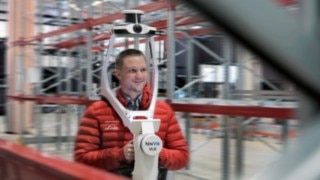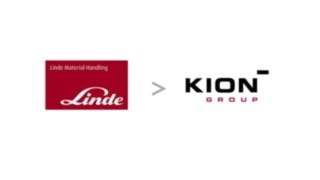
Automation solutions for the present and future
13 Nov 2025
Linde Material Handling showcases comprehensive portfolio, including new products, at the Linde Automation Summit in Aschaffenburg
How can the transformation toward higher levels of automation succeed in the intralogistics sector? At the inaugural Linde Automation Summit, held November 12–13, 2025, speakers shared diverse insights on this subject. Presentations and live demonstrations provided an opportunity for customers, consultants, and trade media representatives from across Europe to experience the extensive range of products and services offered by Linde Material Handling (MH), including its large vehicle portfolio, flexible software and innovative AI technology. The company’s customized, cost-effective automation solutions are meticulously tailored to suit the specific needs of each individual customer. Key components in this context include the holistic consulting approach and in-depth understanding of processes by Linde MH’s automation experts.
“There has never been a better time to invest in the automation of material flow processes,” says Ulrike Just, Executive Vice President Sales & Services Linde MH EMEA and the event’s host. “The systems have become much easier to use and more cost-effective, while project planning and implementation times have been significantly reduced. This facilitates getting started with automation and generates opportunities for enhanced competitiveness. For companies with existing experience in automation, it also offers the opportunity to actively participate in the development of new technologies with Linde MH as a partner,” she explains.
According to Just, Linde MH’s primary competitive advantage is the contextual expertise of its sales and service organization. “Our company’s strength lies in our large number of experienced experts. They understand which automation solution is best suited to each individual case, enabling our customers to achieve consistently high performance.” Reliability and future-proofing are equally important for customers. “Our teams provide comprehensive support to companies every step of the way – from initial consultation to project planning and implementation, and even after commissioning during ongoing operations.”
Extensive product portfolio with new additions
To accelerate the planning and implementation of automation solutions and make them more cost-effective, Linde MH has redesigned key products in its portfolio over the past two years. This includes (counterbalanced) pallet stackers, reach truck and VNA truck models, all of which have been upgraded to an industrial series standard. In conjunction with AMRs, shuttle solutions, stationary automation, and racking systems, this provides a comprehensive, modular toolkit that can be used to plan and implement a wide variety of customer projects with pinpoint precision. At the same time, it is possible to produce tailor-made products to meet specific customer requirements.
New vehicle developments are already underway. A notable highlight of the Linde Automation Summit was the innovative Linde RoCaP, which marks a breakthrough in automated order picking in warehouses. Representatives from Linde MH and the drugstore chain ROSSMANN introduced the vehicle together. Based on the automated pallet stacker Linde L-MATIC HD k, the vehicle additionally features an intelligent robotic arm that is permanently attached to the fork carriage. It lifts packages from the rack and places them on the load carrier. Customized load-bearing equipment for use with roll containers was developed specifically for applications at ROSSMANN. Since the Linde RoCaP can work side by side with manually operated industrial trucks, it is ideal for use in inventory warehouses. At ROSSMANN, it eases the workload on warehouse employees, especially when it comes to picking heavy containers.
Another highlight of the event was a preview of the company’s first automated counterbalanced forklift truck. The Linde E-MATIC, designed for outdoor use, is scheduled to be released in 2027. The robust vehicle offers a load capacity of 2.3 tons, side shifting capabilities, a lithium-ion battery, and extensive navigation and safety technologies. It will initially be used for horizontal transport between drop-off points on the ground or stationary conveyor systems. As early as 2026, pre-series projects will commence with a select group of customers, whose experiences will contribute directly to further development and series maturity. As the Linde E-MATIC progresses through its development stages, it will be equipped to handle an expanded range of tasks, including navigation between indoor and outdoor environments, traversing larger inclines, and managing the storage and retrieval of goods from racks or block warehouses. Additionally, it will be capable of performing lateral loading and unloading operations for trucks.

The Linde E-MATIC automated counterbalanced forklift truck is designed for outdoor use and is being developed in several stages.

The Linde E-MATIC automated counterbalanced forklift truck is designed for outdoor use and is being developed in several stages.
“With the introduction of the first counterbalanced forklift, we have successfully automated the core product of our Linde brand,” stated Ulrike Just, senior brand representative at Linde MH. “Our objective is to be the first major industrial truck manufacturer to put the vehicle into series production. This comes as a direct response to the numerous requests we have received from our customers, and it further solidifies our claim to be the technology leader in our industry.”
AI as an automation accelerator
Linde MH is advancing automation not only with regard to vehicle development. The company also showcased the next steps in implementing physical AI and digital twins based on MEGA, the NVIDIA Omniverse for industrial applications. This included the real-time integration of a digital twin in the NVIDIA Omniverse, which connects a company's AGV fleet manager with a physical AGV. Participants at the event could see on screen how every action of the AGV – navigation, load handling, etc. – is mirrored simultaneously in the Omniverse environment, enabling real-time monitoring, simulation and optimization of logistics processes.

A 3D scanner unit is used to create a fully realistic, three-dimensional image of the environment. This accelerates and simplifies the planning of automation projects.

A 3D scanner unit is used to create a fully realistic, three-dimensional image of the environment. This accelerates and simplifies the planning of automation projects.
In addition, it is now possible to generate high-resolution 360° images using 3D laser scans, thereby creating a digital, three-dimensional map of factory or warehouse layouts. Similar to Google Street View (driving through streets in a car), an operator walks through the facility, wearing a shoulder-mounted frame equipped with high-speed LiDAR scanners using SLAM technology. The device precisely captures the environment, creating a three-dimensional image of reality. The entire process takes no longer than 40 to 60 minutes.
In NVIDIA Omniverse, a digital twin of the site is created with the help of the 3D scan. The 3D visualization provides precise measurements, including distances between shelves, distances between two points, and the floor slope along designated routes. This reliable basis for planning eliminates the need for further on-site visits. All project participants can then work together on the modeled, realistic image and share information, such as marking critical areas in the warehouse, adding comments, and noting suggested solutions. In recent months, the portable laser has already been used to create a dozen scans at various locations throughout Europe. At the Linde Automation Summit, participants had the opportunity to gain hands-on experience with the technology at the event venue, the Linde Experience Hub, learning how straightforward it is to use and implement. The coming year will see the initial implementation of customer applications in which 3D visualizations are utilized to plan and virtually test automation solutions with the help of digital twins, enabling on-site commissioning much faster than in the past. These capabilities will also be offered as a separate service.
Software ensures flexibility and future viability
Faster and more cost-effective automation – this is ensured not least by the MATIC:move software platform introduced with the new automated vehicle models. Intuitive operation and visual workflow design facilitate the planning and implementation of material flow processes without extensive programming expertise, based on the “low-code” principle. The result is a significant reduction in the time required for commissioning, from weeks to just a few days. For more complex requirements, MATIC:move+ is available. This extended software version offers additional interfaces and functions, as well as intelligent traffic control for demanding processes. This keeps the solution flexible and scalable – from individual vehicles to large (mixed) fleets. Vehicles from third-party manufacturers and stationary systems can be integrated via the Linde Warehouse Manager and VDA-5050 compatibility. This approach ensures transparency, comprehensive control and adaptability.
All Linde MH automation solutions are distinguished by their built-in safety expertise, which is deeply embedded in their DNA: Multiple redundant systems, advanced sensor technology, and specialized lighting solutions such as the “red warning lights” on the right and left sides of the vehicle all work together to protect people, goods, machines, and infrastructure. This approach not only helps achieve a high throughput of goods per hour, but also ensures that manual and automated processes can run smoothly side by side.

